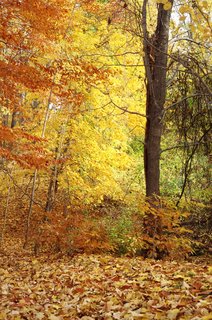

In my first entry, I noted that I had started back on the road to photo recovery. Recently I have used my two Olympus 35SP cameras to shoot Kodachrome 64 and some Fuji Reala 100. The former is, of course, a transparency or slide film, aka a "chrome". The latter is a fairly low speed (by current standards) colour print film.
The 35SP is a vintage 1969-73 camera. As a rangefinder (RF), you do not view through the lens, but rather through a viewfinder window on the back of the camera's top plate. Focusing is manual, via aligning two images together in a central RF "patch". In other words, doing this finds the range, or distance of your focus point. This is a time-honoured and very accurate way of focusing, provided the RF mechanism is aligned properly. (I had both my SPs undergo a CLA [Clean Lubricate Adjust], so they are both accurate, with spot-on meters and shutters.) This method is especially useful in low light. And because there is no mirror as is necessary with an SLR, there is less noise and vibration when an exposure is made. So RFs (e.g. Leica, Contax, the new Zeiss-Ikon [drool!] and a host of others) are great for street shooting, discrete situations, etc.
The 35SP has a fixed lens, i.e. it is not interchangeable, as with a Leica, Contax, or ZI. The lens is a really sharp 42mm f1.7 G. Zuiko. (The G signifies that it has 7 glass elements, G being the 7th letter of the English alphabet.) 42mm is about the perfect focal length in 35mm photography to approximate the human field of view without peripheral vision. For much of my work in the past I have preferred a 35mm focal length; the slightly wider perspective provides some extra context, and is similar to what you perceive with that peripheral vision that the 42 (or up to 50mm) does not.
But in the last year or two I've considered that the "normal" (42-50mm) focal length has its merits. The perspective is enough different to force you to see differently when composing. And the slightly longer focal length, combined with the fact that these normal or "standard" lenses usually come with a wider aperture that limits depth of field, makes for some versatility when you need to isolate the subject by ensuring that the background is pleasantly out of focus.
In addition, I consider it a really important practice to really master a piece of equipment. So I make a point of often going out with a camera and only one lens. I.e., if I go out with an SLR, I can take along any number of different lenses. Choice is good, but the discipline of not having the choice of "which lens do I use?" has its own merits. It forces you to truly see, not just use gear.
Years ago I pretty much mastered the 35mm lens and the 100mm lens. Too bad I didn't master the 50mm (or nearly 50mm), since those are often both technically wonderful and cheap. (35mm camera manufacturers have made more 50s than any other focal length. They got good at the optical formulae, and they got good a production efficiency. Olympus produced at least five differnet 50mm/f1.8 lenses for the OM series. Then there were several versions of the 50/f1.4, the 55/f1.2, the 50/f1.2, the 50/f2 macro, and the 50/f3.5 macro. All were at least very good lenses. Even the early 50mm/f1.8 F.Zuiko, the least well regarded, had its charms. Wide open it wasn't great, but with its single coating (versus multi-coating), it had a glow and colour signature that was unique in the family. Use it with black and white film at mid-apertures, and you get a classical look.
So, I'm back to concentrating on the standard focal length, and the 42mm on the SP is a compromise between the 50 and 35. Sure, I'll use a different lens when the situation demands it, such as a super-wide for a large group shot, a 100mm for a tighter portrait and/or better background separation. But I'm going to wear the standard lens around my neck for awhile and let it teach me.
That said, I've posted a couple of recent shots above, made with the Olympus 35SP (body #1), shot on Fuji Reala 100 print film. The lab scanned the shots to high resolution TIFF files, and I then downsized and supplied minimal sharpening in Photoshop. My PS skills aren't well-developed, but I think they look OK. Both were taken at Durand Eastman Park in Irondequoit, NY, 05 Nov 2005.
No comments:
Post a Comment